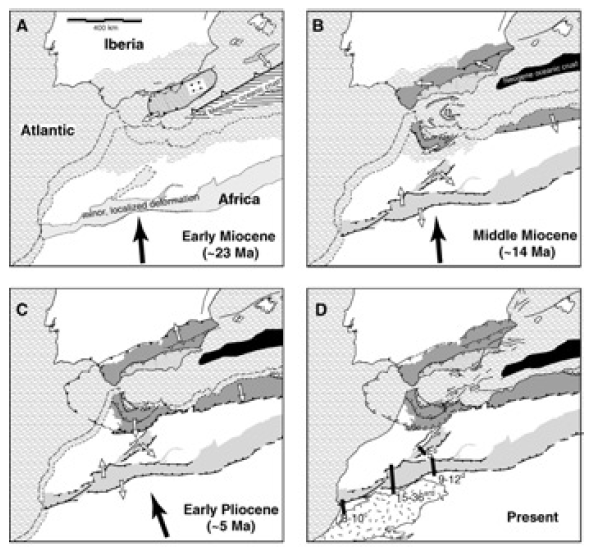
The magnitudes and timing of deformation in the intracontinental Atlas Mountains of northern Africa suggest that the Atlas Mountains have been an integral part of the African-Eurasian plate-boundary zone in the western Mediterranean during the Cenozoic. Shortening of the Moroccan Atlas has accommodated 17%–45% of the total African-Eurasian plate convergence since the early Miocene, whereas the majority of the plate convergence is accommodated in the Rif-Betic-Alboran region. Although the latter underwent other geodynamic processes, as demonstrated by extension of the Alboran Sea contemporaneous with plate convergence, shortening directions in the Atlas are generally consistent with ongoing plate convergence and show no influence of these additional processes. In the framework of plate tectonics, the western Mediterranean region, including the Atlas system, should be regarded as a diffuse plate boundary in which the Atlas Mountains comprise narrow deformable zones bounding larger, relatively rigid crustal blocks. The deformable zones reflect the influence of crustal structures inherited from a major early Mesozoic episode of intracontinental rifting in the Atlas.
This paper was published in Geology by the Geological Society of America (GSA), and GSA retains the copyright.
Geological Society of America, P.O. Box 9140, Boulder, CO 80301-9140
Figure 2. Paleotectonic reconstructions of western Mediterranean region. White arrows denote directions of local tectonic transport. White and black teeth denote inactive and active thrust faults, respectively. Large black arrows denote movement of Eurasia relative to Africa at times shown (after Dewey et al., 1989). Present day (D) includes shortening estimates in Atlas where heavy black lines mark locations of cross sections along which shortening was estimated; numbers denote magnitudes of horizontal contraction in kilometers. Sources of shortening estimates: a—Beauchamp et al. (1999), b—Gomez et al. (1998), c—Mustaphi et al. (1997), d—Zouine (1993). See Figure 1 (see reference) for pattern and symbol definitions.
